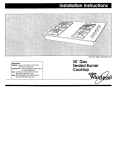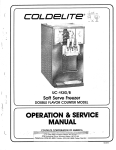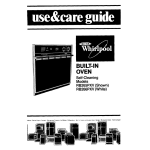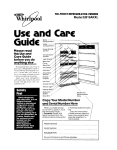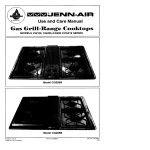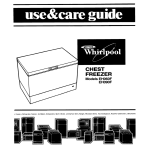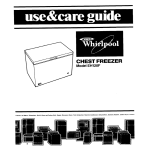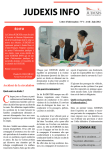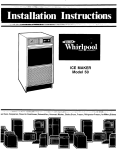Download Whirlpool CHE-12RC User's Manual
Transcript
3Lirlpool AUTOMATICICE CUBE MAKER User’s Instructions & Care and Cleaning Guide MODEL - CHS12RC CHSl2RS CHE-12RC CHE-12RS General Information The machine produces clear hard ice by circulating water over a freezing plate. As the water freezes into ice, minerals in the water are constantly being rejected and a clear sheet of ice is formed. When the desired thickness is reached, the ice sheets are released and slide ontc a cutter grid where the sheet is divided into individual cubes, At the end of each freezing cycle the water containing the rejected minerals is discharged to the drain. Fresh water then enters the machine for the next ice making cycle Cubes fall into the storage bin. When the bin is full the ice maker shuts off automatically and restarts when the ice supply needs replenishing. Operation of the machine can needs in the following manner. START TIME \ I STOP TIME be tailored to the user’s Set the timer to the present time of day within proper day or night portion of the control dial. the Set the “time to start” knob (white) to the hour at which machine operation is to begin. The knob must be depressed slightly and then rotated around the timer bezel to the time setting selected. The push button switch located on the control panel at the top of the machine has four selections. The “normal on” position is used when maximum ice production and full bin capacity is needed. The “timed on” position is used in conjuction with the “production volume control” timer. “clean” position is used whenever solutions are The circulated through the water system for scale removal or sanitizing. At the “clean” position, only the water pump operates, The “off” position shuts the entire machine off. Operation of the machine will normally require setting the selector switch to the “normal on” position. With this setting daily ice usage should be great enough to completely empty the ice storage bin at least once. If this type of usage does not occur, the ice left in the storage bin will have a tendency to cluster or freeze in chunks making ice difficult to remove from the bin. The purpose of the timer control is to allow a user to tailor the daily ice production of the machine to the user’s ice requirements, This prevents an excess of stored ice with the resulting ice clustering problem. Once the timer and switch is set, daily operation automatic and need not be adjusted or changed unless requirements change. is ice Set the “time which machine to stop” operation knob (black) to the hour is to terminate. at Set the push button service switch to the “timed position. The start time should be selected to allow machine to produce enough ice for “start requirements. The “off time” should be selected allow the machine to produce enough ice needed the entire day. on” the up” to for With the selector switch in the “normal on” or “timed on” position the signal light will glow with a low intensity and is an indication that the electrical power is on. When the harvest cycle is longer than three minutes the signal light becomes brighter and begins to blink. This indicates a malfunction of the harvest cycle. NOTE: The machine will generally resume normal operation within a period of twenty (20) minutes after such a malfunction does occur. If the signal light repeats indicating a malfunctioning harvest cycle, a qualified serviceman should check the machine. Circulate for “off” position 7. five minutes, Then set service to syphon out the water. switch Set service switch to “clean” position. Slowly pour the cleaning solution into the water reservoir pan. If the solution foams, stop pouring until the foam subsides and then pour the rest of the solution. 8. Allow the solution to circulate until freezing plate surface has dissolved. the scale on the 9. When the plates are clean, place the service switch the “off” position. Thus allows the cleaning solution syphon out of the reservoir pan into the drain. NOTE: Severe scale formation on rna y require repeating the cleaning quantity of solution if after 20 orculating all the scale deposits are I to in to the freezing plates process with a fresh to 30 minutes of not removed. If scale deposits remain on the side flanges a stainless steel sponge or pad dipped rn cleaning solution can be used to scrub these surfaces. This can best be accomplished after the removal of the lower water distributors. (see steps 14 & 75) 4. Unlatch the two snap catches and swing the front panel open on its hinges. If there is inadequate clearance to swing the panel open, the front panel can also be lifted off the hinges. The control panel cover may have to be removed to lift the front panel off its hinges. Remove the cover by removing the screws along the bottom front edge. The cover then pulls straight off. CAUTION: Always disconnect electrical power machine when removing the control panel cover. to the The front panel then need only be cracked open to lift it off the hinges. Temporarrly replace the control panel cover as power must be provided to continue the cleaning operation. 5. With electrical power on and the service the “normal on” positlon, proceed to: supply switch 10. Turn on the water supply servrce switch to “clean”. circulate for ten minutes. to the machine and set the Allow the fresh water to 11. Place the service switch in the “off” position and allow the water to syphon off to the drain. When the reservoir pan has refilled with water, place the service switch in the “clean” position and allow the water to circulate for ten more minutes. 12. Place the service switch in the “off” position the water to syphon off to the drain. and allow set to A. Shut off the water to the machine. 6. Lift up gently on the thickness control arm until the water has drained out of the reservoir pan and all ice sheets are off the freezing plates. C Release the thrckness switch to the “clean” control positlon. and set the servrce I 6. Preheat the water system by pouring reservoir pan until the lower pump hot water into the housing is covered. 13. Remove the top water distributor tube. Remove the two wing nuts which hold the distributor tube in position on the top freezing plate. Pull out the water pump hose from the right end of the distributor. Pull out the rubber plug from the left end of the distributor. A stiff bristled brush of approximately the same diameter as the distributor will facilitate removal of scale accumulation. hose connected to the bottom of the pan. The plastic pan should then be moved to the left until the right edge can be dropped off the mounting flange. During removal the pan may have to be flexed slightly. 14. Remove the ice cube deflectors between each cutter grid. The lower left edge has a locking tab which must clear the grid frame. Push left and up on the lower edge of the deflector. The right edge then readily comes off the lower flange of the cutter grid above. Wash the deflectors and distributors with a mild detergent solution, rinse with clean water and sanitize with the sanitizer solution. If heavy scale exists the components may be soaked in cleaning solution to remove the scale. i 17. 15. Remove the lower water distributors. Lift up on the right side and pull the left edge off of the cutter grid. The elastic distributor may have to be flexed slightly to Remove each cutter grid. Unplug the electrical connection and remove the grid switch. Grids are held in position on four studs. Sliding clips free the grids from the studs on the left end and the other end of the grid slides off the studs nearest the freezing plate. The entire grid can be placed in cleaning solution (see item 1). Allow the grid to soak and use a toothbrush to remove scale and mineral deposits on connecting pins and grid wires. get it off the grid flange. 18. Wash the ice maker interior with a mild solution of detergent and rinse with fresh water. Then wipe the ice maker interior with the sanitizer solution (see item 1). 19. Reinstall distributors. grids, mercury switch, deflectors and NOTE: Mercury switches are to be positioned as indicated on the sketch located on the support rail. Incorrect position will result in malfunction of the machine. 20. Wash the interior of the detergent, and rinse with brn interior with sanitizing bin with a mild solution fresh water. Then wipe solution, 21. Place the service switch to the “normal on” on” position to resume the ice making cycle. of the or “timed If the ice cube maker is to be shut off for several months, remove all ice from the bin and then Clean & Sanitize the ice maker. 16. Remove the water reservoir pan. Remove the syphon Water inlet and drain lines must be blown out if the unit will be subjected to freezing temperatures during shut down. Failure to do so may cause the water inlet or drain line to freeze and rupture. Disconnect electricity to the machine and leave the door cracked open to prevent any odor from developing. Water Cooled Models Over a prolonged period of time scale will form on the inside walls of the water condenser which must be removed. When scale forms the ice maker becomes less efficient and requires larger amounts of water for cooling. The scale is cleaned from the inside of the condenser walls with chemicals, It is recommended that the scale removal should be performed by your WHIRLPOOL ice maker dealer. Turn Clockwise To Increase Thickness Air Cooled IN. THICKNESS 3/8” MAX. THICKNESS 1” Thickness of the Ice can be varied by rotation of the inverted “L” shaped adjusting screw which IS located on the thickness control. The thickness control IS mounted on the lower freezing plate. One complete rotation of the adjusting screw varies the thickness approximately 1,‘16”. To increase thickness turn the screw In a clockwtse dlrection. Maximum production of Ice In pounds will be obtained with the control set to produce Ice approximately 1./2” thick. In some areas it may be beneficial to filter or treat the water being supplied to the ice machlne to reduce water system maintenance (see Cleaning & Sanltlzlng the Ice Making System) and to produce the best type of tee For information on fllterlng and treating the water WHI R LPOOL commercial ice maker dealer see your Models Adequate air must be allowed to flow through the flnned coils of the remote condenser A dirty or clogged condenser prevents proper air flow resulting In reduced capacity of the ice machine and subjects the components of the unit to higher than normal operatlng temperatures. The condenser co11 should be Inspected approximately once J month and cleaned when necessary. Use a vacuum cleaner and stiff brush to remove the accumulation of tint and dirt. Impurities are rejected from the circulating water that freezes into ice. These impurities collect on the freezing mechanism and in the water system and form a hard scaly deposit. Generally this scale prevents a rapid release of the ice slab during the harvest cycle and may cause the warning light to start blinking and glow brighter. The water and ice making system, therefore, should be periodically cleaned and sanitized. The frequency of cleaning will depend on local water conditions and how rapidly scale accumulates. Cleaning and sanltlzlng IS not too dlfflcult Having :I quaIlfled service representative clean the system the first time should make subsequent cteanlng easier to perforrn If the operator wishes to take over this portlon of the ICC: machlne maintenance. All components of the Ice maker are lubricated factory and should not require any addItIonal oiling normal life of the machine at the for the Follow this procedure to assule that the ICP rnachlne clean and sanitary. I. Cleaning and sanitizing solutions: Both cleaning and sanitizing solutions are required. Prepare as follows: Cleaning Solution - Mix a solution of powdered citric acid and hot water (see cleaning label on inside of top front panel for quantity to be used). Citric acid is available in most drug stores. Hot water should be used if possible as the citric acid will go into solution quicker and the cleaning itself is accomplished in less time. Commercial ice machine cleaners are also available in liquid form and should be mixed according to instructions on the label. These ice machine cleaners are available through commercial refrigeration supply houses. Periodic inspection and cleaning is necessary to keep your Ice cube maker operating at peak efficiency and to assure a samtary Ice producing mechanism. Your WHIRLPOOL dealer IS well qualified to perform this service for you Sanitizer Solution Common laundry bleach mixed at a ratio of 1 oz. to a gallon of water will make an excellent sanitizing solution. Enamel finishes may be cleaned simply by wiping with a damp cloth. Regular use of a good household appliance cleaner and wax IS recommended for protecting the finish StaInless steel cabinets require the use of a stalriless steel cleaner Carbonated water may be used as a cleaner If <i regular stainless steel cleaner is not available IS 2. Set service 3. Remove switch to “off” all ice from position, the storage bin. Check the following A. before calling a service Unit does not run: 1. Make sure service switch on” or “timed on”. 2. 3. man: is posltioned If service switch is in “timed on” control timer must be in the timed allows the machine to operate. Check fuses in power and remote refrigeration supply unit. to “normal position then setting which to ice maker C. Unit I, runs but produces no ice: D. Check all mercury switches positioned over water trough. Arms must be vertical. If switch arms are not vertical, check for bind. Check position of switch capsule in bracket against sketch on support rail. WHIRLPOOL Benton Harbor, Vacuum B) Check fuses in electrical control panel. These fuses control low voltage current to cutter grids, relays and ice thickness control. Unit runs but produces very little Systems, position for on” position. one ice: 1. Operation of remote condensing high temperatures (normal for be low). unit in extremely ice production to 2. Lint or dirt blocking finned condenser of (check and clean). air flow through condensing unit 3. Check for objects around remote condensing which would obstruct normal air flow. Light on control panel blinks proper remote unit or flashes: 1. Whenever the light is blinking or flashing, it is an indication of an abnormally long harvest cycle. Long harvest cycles are generally caused by ice slabs not releasing properly and may indicate the machine needs to be cleaned. 2. Call a qualified serviceman to check the machine if the above suggestions do not remedy the problem. Michigan. Washers, Refrigerator-Freezers, and Surface Units, (Rev. 3. CORPORATION, Wringer Part No. 583886 Push service switch to “off” minute and then reset to “normal head NOTE: If the light on control panel is lit, it indicates power supply is okay to ice making section. Separate fuses must be checked for power to remote refrigeration section. Fuses inside control panel are for low voltage circuits only. B. 2. Manufacturer Clothes Dryers, of Automatic Freezers, Ice Makers, Dishwashers, Ranges, Food Waste Dehumidifiers, Air Washers, Refrigerators, Built-In Disposers, Conditioners. 85 Ovens Central







